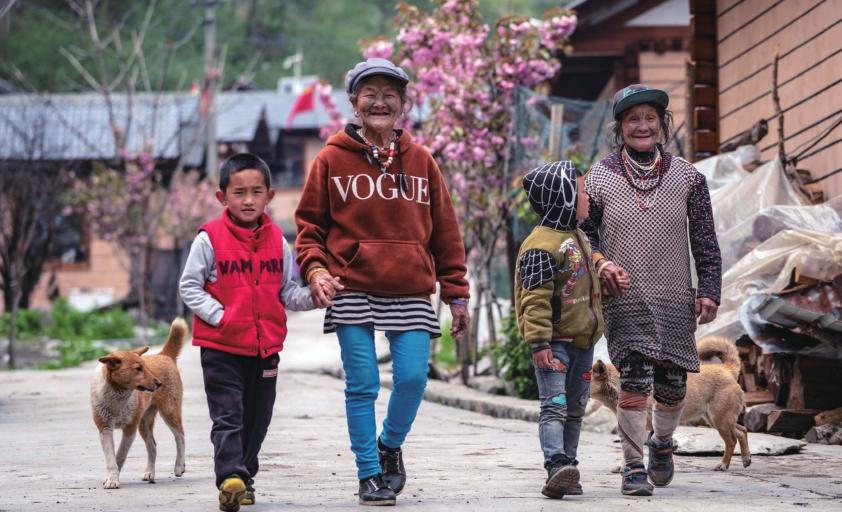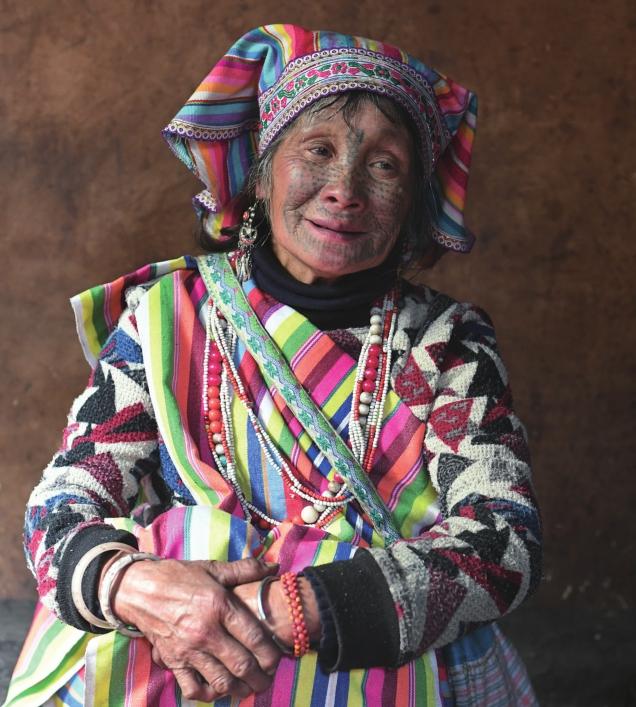TATTOOED LIFE
2019-05-23ByYuanYuan
By Yuan Yuan
It is in her kitchen beside a wood stove that Ken Guofang, a 91-year-old woman from the Derung ethnic group with tattoos on her face, tells her story.
She doesnt speak Mandarin and needs a local youth to translate for her. Smoke from the wood fi re fi lls her eyes with water but she doesnt bother to stop and wipe them.
“I got the facial tattoos before I could remember anything,” Ken said. “It was my mothers decision. She said it was a tradition among Derung women.”
Fading memories
Ken, one of only 20 women still alive from the Derung ethnic group that have facial tattoos, is the last in her family to have gotten them. The number will decrease, since young women no longer follow the tradition.
Women with facial tattoos are a unique phenomenon within the Derung ethnic group. The majority of its people live in Dulongjiang Township, an enclave isolated from the outside world by rolling mountains bordering Myanmar in southwest Chinas Yunnan Province. There was no road to the township until 1999.
In 1961, a documentary fi lm on the Derung ethnic group featuring footage of facially tattooed women was released. Li Yongying, who had just gotten her facial tattoos during that period, was in the documentary.
“They were filming a wedding in our township and needed somebody to be a bridesmaid,” Li said during an interview with China Central Television (CCTV) in the early 2010s. “I think it was all because of my facial tattoos that I was chosen for the event.”
Since the 1960s, fewer Derung women have gotten facial tattoos. Dong Chunlian, born in 1957, got hers in 1970 at the age of 13. She is the last Derung woman to have gotten facial tattoos.
Different from other tattooed Derung women, Dong has more connection with the outside world. She visited many places in the country instead of clinging to her hometown.
In 2000, as a representative of the Derung ethnic group, she went to Taiwan for a cultural exchange and has since been to many places in the mainland for the same reason. In 2017, she was employed in the Yunnan Nationalities Village based in Kunming, capital city of Yunnan, to introduce and illustrate the life of the Derung people to tourists.
She is now settled in Kunming with her family. Unlike many of the face-tattooed women who can only speak in their own language, Dong speaks Mandarin as well. In 2015, when President Xi Jinping visited Yunnan, Dong was chosen as a representative to speak with Xi.
Wang Qingyuan, a 57-year-old tattoo artist from Beijing, learned about this tradition of Derung women and tried to go to Dulongjiang Township to meet them in 2004. But when he got there, access to the town was blocked by snow. He and his team could only reach the county seat of Gongshan Dulong-Nu Autonomous County, the closest area to the township they could access.
“Luckily, there were a few women with facial tattoos that lived in the county seat of Gongshan at the time and I managed to meet them,” Wang told Beijing Review.
The sight of the tattooed women thrilled Wang. As one of the first generation of tattoo artists in contemporary China, Wang had long sought historical tattoo records, and these women, standing and talking right in front of him, were living proof that China had a long history of tattoos.
By then, the road to the township was already built, but remained unpaved and very bumpy, with occasional landslides creating another obstacle. Few women with facial tattoos managed to move out of the town.
Wang went back to the area in 2007, better prepared. He hired a team of horsemen and finally made it to the town. There were 48 women with facial tattoos alive at the time. He interviewed 47 of them. The one he missed was due to the fact that the womans family had had an accident and she was unable to do the interview. Wang considers it a loss till this day.
During his interviews, Wang videotaped everyone and based on these videos, Michael McCabe, an anthropologist and tattoo art researcher from the United States, wrote a 14-page story titled Tattooed Women of Yunnan China, which was published in Skin & Ink, a major U.S. magazine for tattoo arts, in 2008. The magazine launched a special issue for his story, which McCabe claimed may be the longest report on these women in Western media to date.
The story buzzed among tattoo artists and fans in the West. McCabe was actually a friend of Wangs and was part of the team that headed to the township in 2004, but did not take part in the 2007 interviews.
A mysterious tradition
To create the tattoos, a piece of thorn branch from a local plant was used, and the color was made from a mixture of water and the ashes of burned pine trees.
The tattoo artist first drew patterns on the girls face and used a short wooden stick to hit the thorn plant to make it stab the face lightly. After being tattooed, her face would be swollen for more than a week.
“It hurt a lot and I couldnt help crying,”Dong said. “The whole tattoo took almost one day, from early morning to late afternoon. I couldnt chew food for almost two weeks.”
The patterns of the tattoos are quite similar, composed of straight lines, zigzag lines and dots. “Some say the patterns are like butterflies, but I think that is because they are symmetrical, which makes them look like butterflies,” Wang said.
“I dont think these patterns have any meaning,” Qi Nai, a Derung tattoo artist, said during an interview with CCTV. Qi, who had facial tattoos, had tattooed four women before passing away in 2014.
The reason why the women got facial tattoos is still up for debate. Some argue it was used to make the women less attractive in order to avoid kidnappings from stronger neighboring ethnic groups, while others say it was a symbol of the Derung people. Still others claim that the group believed the soul wouldnt leave a womans body if she didnt have tattoos on her face when she died.
Wang is more inclined to believe the first one.“Derung was a weaker ethnic group in the old days and was easily the victim of stronger ethnic groups including Tibetan and the Lisu ethnic groups,”Wang said. “This was their way of protecting the women from kidnappings; the facial tattoos, in my opinion, record the history of misery.”
McCabe, though, has a different opinion. “There is another possibility,” he said. “It could also have been a way to prohibit the women from leaving the land they live, a way to control them.”
No matter what was the real reason, the life of tattooed Derung women now is totally different from that of their former generations.
“Our life has changed fundamentally compared to the old days,” said Li Wenshi, 75, who got her facial tattoos at the age of 11. She was also among the representatives to meet with Xi in 2015.
“When I got facial tattoos, all Derung women had them. If you didnt do it, you felt uneasy, like an alien,” Li recalled. “Now, no young girl would accept it. After we pass away, the tradition will disappear.”
